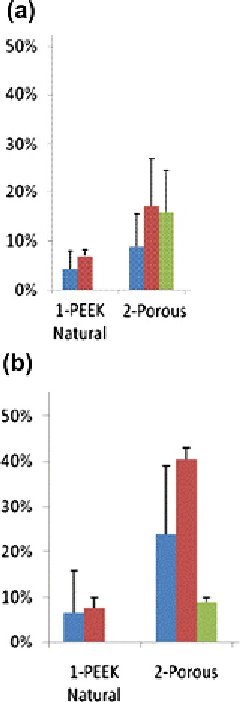Biomedical Engineering Reference
In-Depth Information
this may entirely depend upon application and
anatomical location of the implant. The presence of
porosity on the current PEEK samples affected the
mechanical properties, significantly reducing the
mechanical properties observed for solid PEEK.
However, this reduced modulus may be beneficial for
nonload-bearing applications or designs in combi-
nation with other supporting materials. When
osseoconductivity is not required, the porous PEEK
foam demonstrated a new set of mechanical proper-
ties that may be of use in the device designer's
toolbox when attempting to recreate different tissue
gradients. The positive in vivo results also suggest
that whilst the porosity created with this technology
is restricted, it may still be adequate to confer
a benefit and it is a process that has no adverse effect
on the PEEK feedstock material.
12.6 Case Study 2dComparison of
Small and Large Pore Sizes
Although the pore size in case study 1 was suffi-
cient to confer some beneficial properties towards
osseoconductivity, for this second case study inves-
tigation the porosity was increased to more accu-
rately represent the configuration of trabecular bone.
With the creation of larger pores and a more open and
interconnected porosity, the reduction in PEEK
structure will have implications for the retention of
strength. The porous metals that have achieved pore
sizes similar to that of trabecular bone (~700
m
m)
have the ability to retain sufficient mechanical
properties for orthopedic applications such as
augments or backing on acetabular cups. A porous
PEEK with porosity and structure similar to trabec-
ular bone is likely to possess mechanical properties
similar to actual trabecular bone. This naturally
means that the material must be treated as a bioma-
terial alternative to bone rather than an analog to the
porous metals. The benefits of creating a material
from PEEK mean that the material can be trimmed
and formed in situ and is radiolucent to permit
observation of any ingrowth, and that the look and
feel is like that of bone. In order for a porous PEEK to
meet both the ingrowth and strength requirements
that could be required to be consistent for predicates
in certain applications, it may be necessary to create
hybrid solid
e
porous materials.
To examine the matching of the porosity to
trabecular bone and the effect on mechanical
Figure 12.7
Percent implantecortical bone contact (a)
and percent implantecancellous bone contact (b) for
solid (PEEK natural) or porous PEEK. Percentages
increased over time for aged sheep from 4 weeks
(blue) to 12 weeks (red). Percentage was also influ-
enced by age, with comparable implantebone contact
present at 4 weeks duration for the 18-month sheep
(green). There was no significant difference between
solid or porous due to
n
¼
3.
were inaccessible by the surrounding tissue.
However, the extent of required porosity can be
debated since sufficient fixation may occur in the
superficial first millimeters of an implant surface and
presence of porosity further than this may make the
material more prone to the creation of dead-spots that
are isolated from nutrient transfer. The continued
presence of non-interconnected pores in the bulk core
of this material may also facilitate the transfer of
force vectors and aid in mimicking in vivo tissue.
For subsequent improvements in osseo-
conductivity, a mean pore diameter larger than
70
m
m and greater interconnectivity would be likely
more preferable for osteoblast ingrowth. However,

